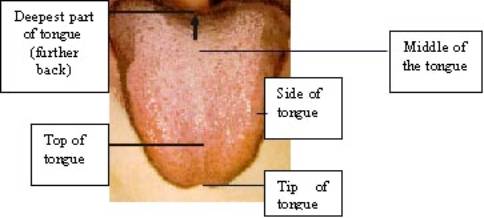There are four areas of the tongue used for articulation. The deepest part, the middle, the sides, and the tip. The following picture helps pinpoint these areas.

Middle of the Tongue
Three letters use the middle of the tongue for their articulation. They are ![]() ,
,![]() , and the
, and the ![]()
These three letters are articulated from the middle of the tongue and what lies opposite to it from the roof of the mouth. This means the middle of the tongue collides with the roof of
the mouth when these letters are articulated without a vowel, and the middle of the tongue separates with strength from the roof of the mouth when the letters are voweled. The ya’ here is not the medd letter ya’, which was previously stated to be articulated from the non specific area of the empty space in the throat and mouth. The medd letter ya’ is a ya’ saakinah preceded by a kasrah, NOT a fath. When the ya’ saakinah is preceded by a fath, this currently discussed articulation point is used.
Common mistakes in these letters
The mistakes that may occur with these letters tend to more in the area of characteristics than in the specific articulation point, but not exclusively so. The![]() is often mispronounced by Arabs and non Arabs alike, with a running of the sound, like the French “j”. This letter, in Arabic, is a strong letter, and there is imprisonment of the running of the sound, and imprisonment of the running of air. To pronounce it correctly, first make sure the middle of the tongue is being used, and not the anterior portion of the tongue, then concentrate on not letting any sound and air run out when saying the letter.
is often mispronounced by Arabs and non Arabs alike, with a running of the sound, like the French “j”. This letter, in Arabic, is a strong letter, and there is imprisonment of the running of the sound, and imprisonment of the running of air. To pronounce it correctly, first make sure the middle of the tongue is being used, and not the anterior portion of the tongue, then concentrate on not letting any sound and air run out when saying the letter.
![]() can be articulated incorrectly, especially by those with a significant overbite. Those that may have an overbite have to take the extra measure of protruding the lower jaw until the bottom and top teeth are aligned. It may take a little practice, but is indeed possible to pronounce it correctly, even with the overbite. There is a lot of air that fills the mouth and runs out with this letter. Westerners sometimes pronounce this like the English “sh”, which has a more forward position than the Arabic .
can be articulated incorrectly, especially by those with a significant overbite. Those that may have an overbite have to take the extra measure of protruding the lower jaw until the bottom and top teeth are aligned. It may take a little practice, but is indeed possible to pronounce it correctly, even with the overbite. There is a lot of air that fills the mouth and runs out with this letter. Westerners sometimes pronounce this like the English “sh”, which has a more forward position than the Arabic .
